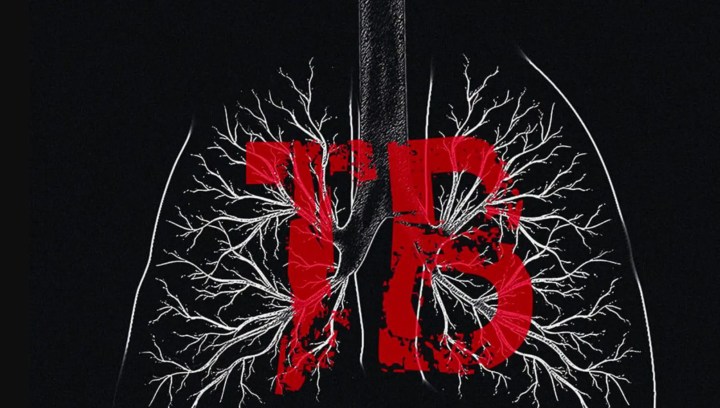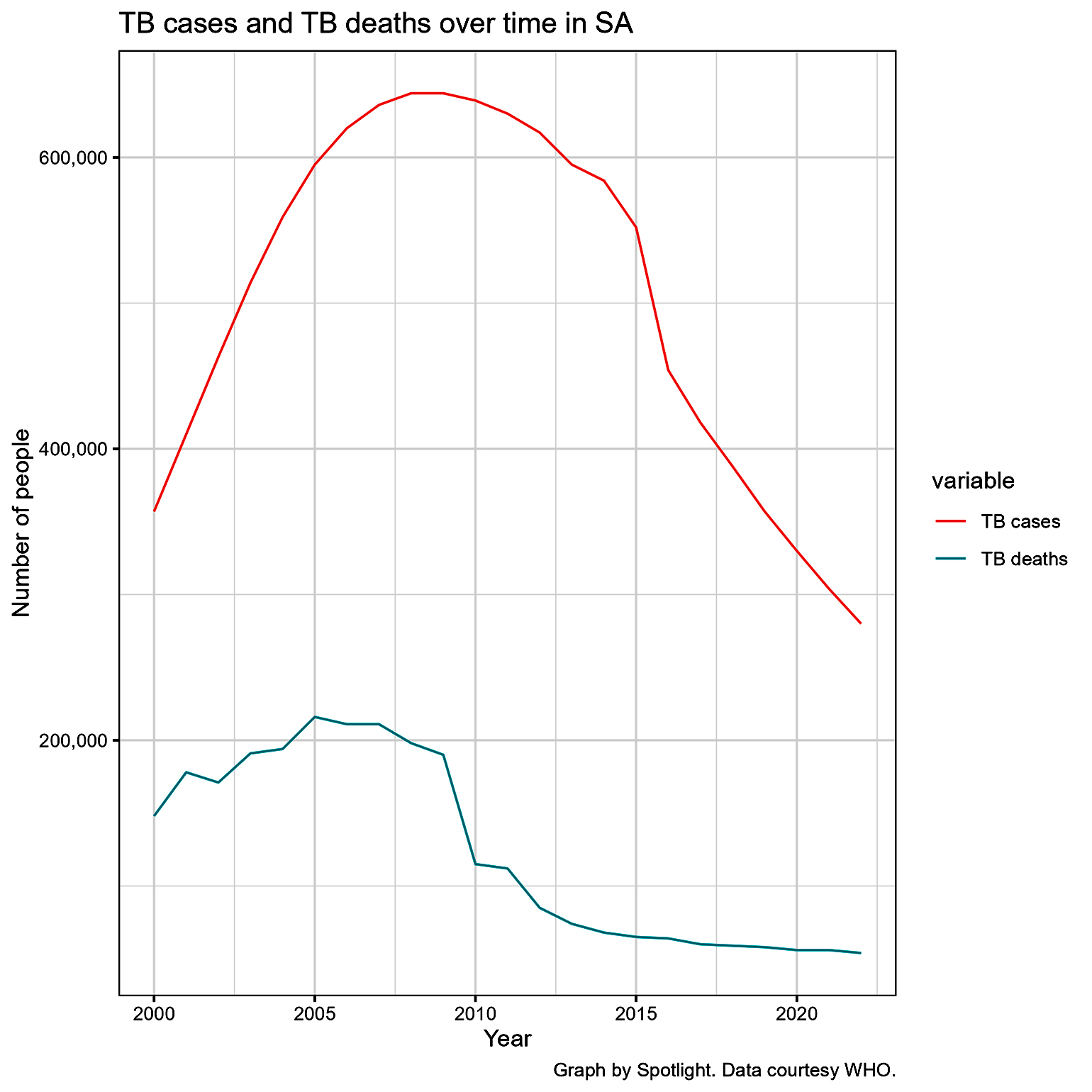SPOTLIGHT IN-DEPTH
What the new WHO TB numbers mean for South Africa

An estimated 54,000 people died of tuberculosis in South Africa in 2022 and about 280,000 fell ill with the disease, according to just-released figures from the World Health Organization. Catherine Tomlinson unpacks the figures and what they mean for the country’s TB response.
These WHO figures indicate that South Africa is meeting its targets relating to the reduction of TB cases, but not when it comes to reducing deaths due to TB.
The new numbers are from the WHO’s 2023 Global TB Report published this week. In addition to the main report, the WHO also published several country profiles – South Africa’s is here.
TB targets
As a member of the United Nations (UN), South Africa has committed to achieving the Sustainable Development Goal (SDG) to end TB as an epidemic by 2030. To achieve this, South Africa and other UN member states have committed to reduce TB cases by 80% and TB deaths by 90% by 2030, compared with 2015 levels.
The WHO has provided milestones that countries must meet in the lead-up to 2030 to enable attainment of the SDG target. The UN-hosted Stop TB Partnership has also specified targets that countries were required to meet between 2018 and 2022 to realise the commitments made in the Political Declaration of the 2018 UN High-Level Meeting on TB.
This year, UN member states reaffirmed their commitments to end the TB epidemic by 2030 during the 2023 UN High-Level Meeting on TB and set out new targets to achieve this goal in an updated political declaration.
How is South Africa doing in reducing TB cases?
South Africa has committed to reduce new TB cases by 80% by 2030, compared with 2015 levels. In 2022, 280,000 people in South Africa fell ill with TB, according to the new WHO data, down from 552,000 TB cases in 2015.
The number of TB cases per 100,000 people has also come down. In 2022, 468 of every 100,000 people living in South Africa fell ill with TB, compared with 988 of every 100,000 people in 2015.
This equates to a 53% reduction in TB incidence between 2015 and 2030 which, when measured against the WHO’s milestone targets, puts the country in a strong position to achieve the SDG target to reduce TB incidence by 80% by 2030.

The WHO’s End TB Strategy set a milestone target for reducing TB deaths by 50% by 2025 (compared with 2015 levels) – a target that the new data indicates South Africa has already met.
How certain can we be that TB cases are really coming down?
While the WHO estimates that 280,000 people fell ill with TB in 2022, its numbers indicate that there is significant uncertainty about this number. According to the organisation the true number can lie anywhere in the range from 182,000 to 398,000. That said, while the WHO’s estimate for 2022 is somewhat uncertain, its estimates over time show a very clear downward trend (as can be seen in the graph above).
The WHO’s estimate is the product of a mathematical model that takes into account several data sources. This type of modelling is essential for such estimates since it is known that many TB cases are not diagnosed and simply counting the diagnosed cases would result in an underestimate of the real TB burden in the country.
How is South Africa doing in reducing TB deaths?
South Africa has committed to reduce TB deaths by 90% by 2030, compared with 2015 levels. According to the WHO’s latest data, 54,000 people in South Africa died of TB in 2022. Here too there is some uncertainty, with the WHO saying the true value lies between 30,000 and 85,000.
While TB deaths have come down since 2015, the decrease in TB mortality remains far from the WHO’s milestone targets required to meet the SDG target of reducing TB deaths by 90% by 2030.
Between 2015 and 2022, TB deaths in South Africa only fell by 17% – this is less than the WHO’s End TB Strategy milestone target of a 20% reduction by 2020.
At 54,000, TB deaths continued to outpace HIV deaths in 2022, although the comparison is complicated since many people with TB are also living with HIV. According to estimates from Thembisa, the leading mathematical model of HIV in South Africa, an estimated 48,000 people died of HIV-related causes in 2022. An estimated 57% of people who died from TB in 2022 were living with HIV, according to the WHO.
How does South Africa’s scale-up of preventive therapy measure up?
During the 2023 UN High-Level Meeting on TB, countries committed to scale up tuberculosis preventive therapy to 90% of people at high risk of developing TB, including household contacts of people with tuberculosis (including children) and people living with HIV. TB preventive therapy is typically a course of pills taken for three or six months.
In 2022, 305,350 people in South Africa were started on preventive therapy – 5.6% less than in 2021 (321,610). The country is doing better at providing people with HIV with preventive therapy than it is in providing the pills to children who are living with someone with TB. An estimated 62% of people newly enrolled in HIV care were initiated onto preventive therapy in 2022, versus 45% of children living with someone with TB.
In guidelines released earlier in 2023, the Department of Health dramatically expanded eligibility for preventive therapy. Whether this results in higher uptake of preventive therapy in South Africa should become clear with next year’s WHO TB report.
How well is South Africa doing in diagnosing TB and linking people to care?
The WHO measures treatment coverage as the number of notified TB cases divided by estimated new TB cases. According to the WHO, treatment coverage rates in South Africa rose to 77% (range: 54% to 120%) in 2022, up from 57% in 2021. This is the first time that estimated treatment coverage in South Africa has exceeded 60% since the WHO began publishing data.
Of the estimated 280,000 people who fell ill with TB in 2022, 214,295 were diagnosed with TB and notified of their diagnosis in 2022. This means 23% (65,705) of the estimated 280,000 were not diagnosed.
While still far too many people with TB are not being diagnosed and linked to appropriate care, the estimated number of “missing” TB cases in 2022 was significantly lower than the number of missing cases in 2021. In 2021, only 172,194 of the estimated 304,000 people who fell ill with TB were diagnosed and notified, meaning 43% of people with TB were not diagnosed.
The jump in treatment coverage from 2021 to 2022 can most obviously be explained by the harmful impact of the Covid-19 pandemic on health services in 2020 and 2021 and then the recovery from the pandemic in 2022. An interesting question, however, is to what extent new TB testing strategies like targeted universal testing contributed to the increase in 2022.
Drug-resistant TB rates
An estimated 11,000 people fell ill with drug-resistant TB in South Africa in 2022 (range 6,700 to 16,000). Of these patients, 6,781 received a laboratory-confirmed diagnosis of multidrug-resistant TB (MDR-TB) and 809 received a laboratory diagnosis of extensively drug-resistant (XDR) or pre-XDR TB.
The number of people who received a laboratory diagnosis of drug-resistant TB in 2022 was 7,590, while 7,651 were started on treatment for drug-resistant TB.
According to data from the WHO, 66% of people started on drug-resistant TB treatment in South Africa in 2022 were started on the WHO-recommended shorter regimens.
What are the lessons from the new global TB report?
The new WHO data indicate that South Africa is making progress in reducing TB incidence and improving rates of detection and treatment linkage. Despite this, far too many people continue to fall ill with TB in the country, and use of preventive therapy to prevent TB illness remains suboptimal, particularly among children who are household contacts of people with TB.
TB also remains a leading cause of death in the country. In 2022, 54,200 people died of TB in South Africa – or one person every 10 minutes. Between 2015 and 2022, the TB death rate fell by only 17%. A further 73% reduction (from 2015 rates) must be achieved in the remaining seven years until 2030 for South Africa to meet global SDG targets. DM
Note: In some cases the WHO has published both numbers rounded to the nearest 100 and numbers rounded to the nearest 1,000 for the same indicator in different places. In such instances we have opted to use the number rounded to the nearest 1,000.
This article was produced by Spotlight – in-depth, public interest health journalism.






















 Become an Insider
Become an Insider
Devastating to read but fascinating article. Do you have statistics related to area / city / province or only age related statistics?